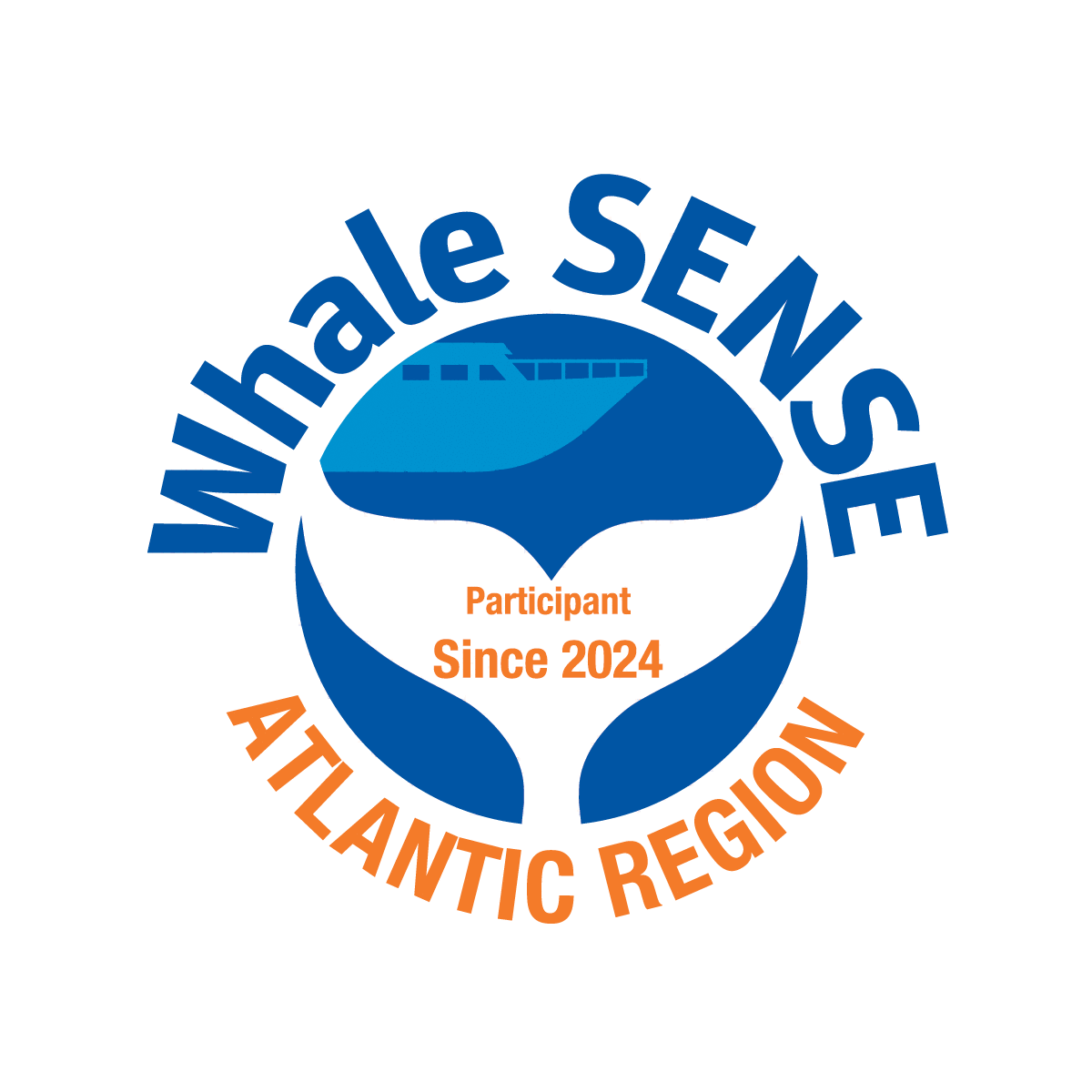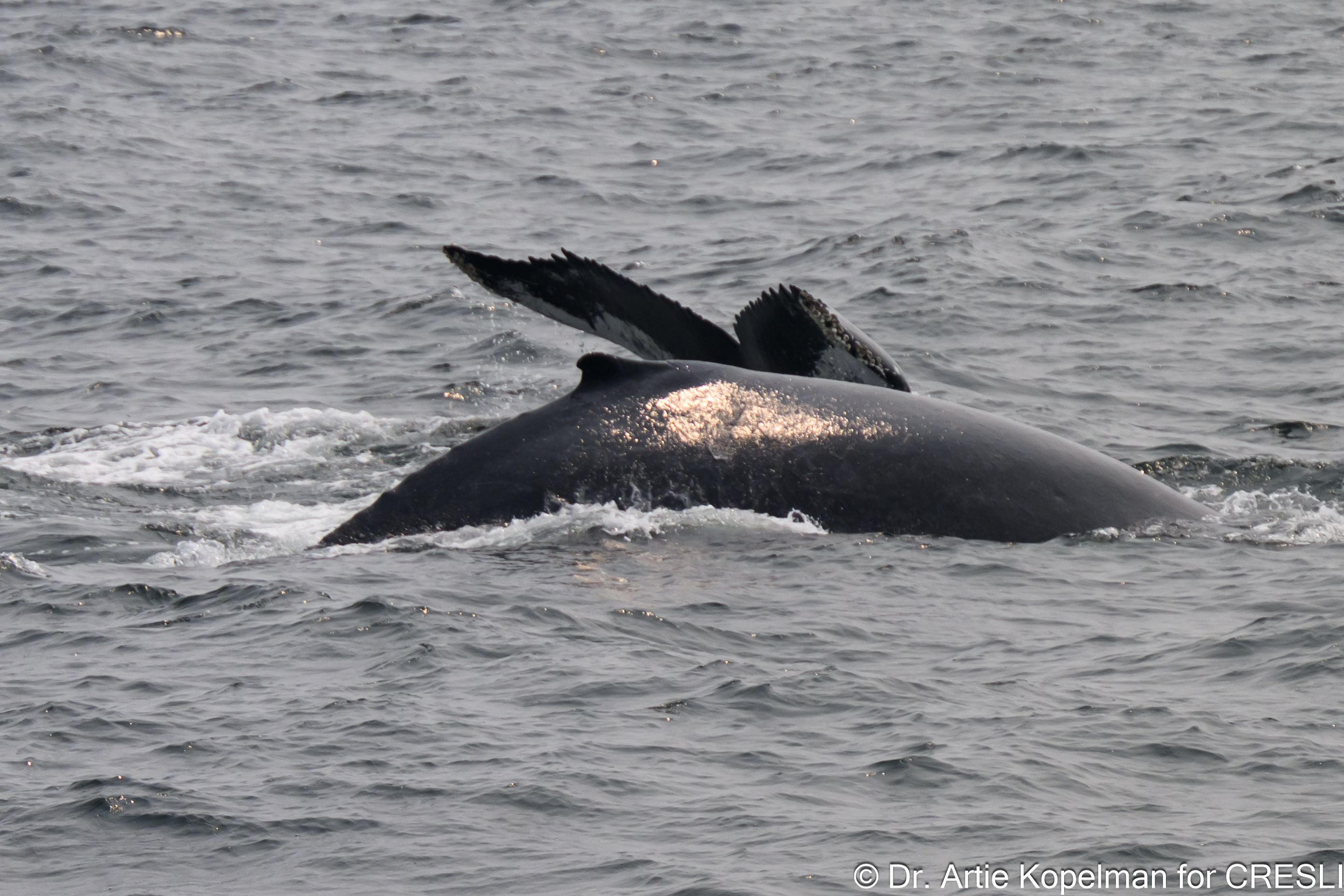Watching Whales
What to expect and what to bring?
By: Arthur H. Kopelman, Ph.D.

Latest CRESLI whale watching trip information and reports:
 The Viking Fleet and CRESLI are proud participants in the National Oceanographic and Atmospheric Administration’s Whale SENSE program. This voluntary program ensures that participating whale watch companies comply with NOAA Fisheries Greater Atlantic whale watching guidelines to prevent harassment of marine mammals. This includes slowing down, managing our time near whales and dolphins, and alerting NOAA of any entangled, ship struck, injured or diseased whales encountered. We are thrilled to be Whale SENSE’s 50th partner and promoting responsible whale watching and stewardship of the marine environment.
The Viking Fleet and CRESLI are proud participants in the National Oceanographic and Atmospheric Administration’s Whale SENSE program. This voluntary program ensures that participating whale watch companies comply with NOAA Fisheries Greater Atlantic whale watching guidelines to prevent harassment of marine mammals. This includes slowing down, managing our time near whales and dolphins, and alerting NOAA of any entangled, ship struck, injured or diseased whales encountered. We are thrilled to be Whale SENSE’s 50th partner and promoting responsible whale watching and stewardship of the marine environment.
WHALE WATCHING FOR SUMMER 2025
CRESLI and the Viking Fleet have scheduled trips from late June through September
- Local trips (5-6 hour trips)
- Offshore trips (36 hour trips)
- All trips are listed in our calendar
We are the only crew with over 39 years of whale watching experience AND professors/scientists as trip leaders. Come away with great memories, great photos and videos, and an education about whales, dolphins, sea turtles, and marine life that is second-to-none.
Meet the CRESLI naturalists/educators
The Viking Fleet vessels are equipped with clean restrooms, comfortable seating and full galleys onboard. We recommend reservations. You can either do so by phone (631-668-5700) or via the link below
Tickets: https://vikingfleet.com/whale-watching-cruises
The regular fare for these trips is $85 for adults, $55 for children 5-12y/o, FREE for Children 4 and under
A LIMITED NUMBER OF DISCOUNTED WHALE WATCHING TICKETS NOW AVAILABLE FOR VARIOUS SUFFOLK AND NASSAU COUNTY LIBRARY PATRONS ($25 fare reduction per person, with restrictions)
- Contact your local library's Adult Services for a promo code
- Promotion is limited to 25 reduced tickets per date and subject to availability.
- Scroll to the bottom of this page and look at RELATED DOCUMENTS
Our colleagues at the Viking Fleet supports CRESLI's work through in-kind donations of providing the vessel and vessel crew, and some funds per trip. We are eternally grateful to the Viking Fleet for our decades of collaboration.
The Viking Fleet and CRESLI are proud participants in the National Oceanographic and Atmospheric Administration’s Whale SENSE program. This voluntary program ensures that participating whale watch companies comply with NOAA Fisheries Greater Atlantic whale watching guidelines to prevent harassment of marine mammals. This includes slowing down, managing our time near whales and dolphins, and alerting NOAA of any entangled, ship struck, injured or diseased whales encountered. We are thrilled to be Whale SENSE’s 50th partner and promoting responsible whale watching and stewardship of the marine environment.
2025 WHALE WATCH TRIPS
|
2 species of cetaceans and hundreds of pelagic birds, but way too many balloons
A great way to start our 30th season with 75-100 Tamanend's bottlenose dolphins, a finback whale, and lots of pelagic birds. Today's trip was a nice way to beat the heat and see wildlife. Our first encounters were with several groups of Tamanend's bottlenose dolphins (Tursiops erebennus), as many as 5-6 groups totaling 75-100 individuals, including some moms and calves in the near shore waters west of Montauk. There were also a few Great shearwaters (Ardenna gravis) and Cory’s Shearwaters (Calonectris borealis). We eventually decided to head southward (offshore). Things were quiet, with a few shearwaters and storms petrels, as we traveled, we reached an area where the ocean became alive with birds, bait, and ultimately a baleen whale. We were in 170’ of water, with prey from the bottom to the surface. We knew we were in the right spot and eventually saw the characteristic 20-foot blow of a finback whale (Balaenoptera physalus). What a pleasure it was to find this majestic, fast, and sleek individual. Finback whales are the 2nd largest animal. We watched it for about 30 minutes before making our way back to the dock. This was our 110th consecutive trip (since 2019) finding cetaceans. While we never guarantee it, we do our best to find them and have been doing it longer than any other group in the NY Bight.
Totals:
Unfortunately, just about every direction we looked, we saw balloons on the surface of the water. We scooped up as many as we could but didn’t have the time to grab more. The ones we removed were graduation celebratory balloons. Come on folks – stop buying and releasing balloons, they are killers.
Photos to view and/or purchase to help support our work - prints, digital copies, and framed artwork available
Here's a slideshow |
|
Another successful trip!!
Totals:
Photos to view and/or purchase to help support our work - prints, digital copies, and framed artwork available
Here's a slideshow |
|
Our 3rd trip of the 2025 season was the 1st time in a while that we didn’t find a baleen whale. It was a great trip nonetheless! The earlier rain/drizzle and dense fog gave way to incredible unlimited visibility. We were all ready to encounter cetaceans (whales, dolphins, and porpoises), as well as pelagic birds. We had reports, but had a planned route to head to where we’d seen that finback whale one 6/29 and 6/30.
As we headed out, we encountered a small pod of about 20 Tamanend’s bottlenose dolphins, along with a few Great Shearwaters and Cory’s Shearwaters. In a short while, we encountered another group of about 50-75 Tamanend’s bottlenose dolphins, as well as more shearwaters, and Wilson’s Storm Petrels. The area offshore where days before we found the whale and loads of bait fish throughout the water column (surface to 170 feet) not productive. We headed closer to shore and ultimately came across a massive aggregation of Tamanend’s bottlenose dolphins. We watched as several pods joined together repeatedly top interact and feed. Captain Dave Marmeno told us that the bait profile on the sonar was indicative of squid, and lots of it. These dolphins were spending a lot of time beneath the surface, most likely feeding on those deep squid.We saw moms and calves, adults, juveniles. It was a pleasure to watch. Eventually we had to head back to the dock and a few saw a seal just of Gin Beach. Please note that as members of the Whale SENSE system, we are committed to responsible whale watching and will always abide by the constraints of the Marine Mammal Protection Act and never harass, chase, or disturb them.
Totals:
Photos to view and/or purchase to help support our work - prints, digital copies, and framed artwork available
Here's a slideshow |
YOU CAN HELP SUPPORT CRESLI when you view and purchase images/prints/artwork
What should you bring on the whale watch?
- You will be on a moving vessel, yes it will rock, but we won't go out if conditions don't warrant it (i.e., dense fog, strong winds, severe weather, and seas greater than 7 feet).
- Be sure to keep your camera away from sea spray, that is, keep it contained until we get near wildlife. Have a towel to wipe off your camera; have lens cloth; protect the front of your lens with a neutral density or UV filter
- You should be prepared for a variety of weather conditions.
- Have several layers of warm clothing (particularly early in the season) available; have foul weather gear available.
- It's always better to be a "MORE-ON" than a "LESS-ON", i.e., you can always take off layers of clothes if you are too warm, but if you are cold, it's hard to add layers that you don't have.
- Have several layers of warm clothing (particularly early in the season) available; have foul weather gear available.
- Shoes ... strong, sturdy, flat, non-skid, rubber-soled.
- A hat ... under cold conditions much body heat is lost through your head. During warm weather a hat is needed to protect you from the sun, rain, etc..
- Sun screen ... that blocks UVa and UVb. VERY IMPORTANT!
- Sun glasses ... VERY IMPORTANT!
- Sea-sick medication .... If you are prone to motion sickness, take medication well before coming on board
- Camera
- Binoculars
- The vessel has a full galley with food and drinks for purchase, but also feel free to bring your own.
Precautions to prevent or reduce motion sickness?
- Do not think about getting seasick. You're on a safe vessel and like any other vessel, it may move in many directions at once. Keep your eyes looking out over the horizon and stay outside.
- Make sure that you have some layers to put on in case you get cold
- Make sure that you’ve eaten well before coming on board. Bring pretzels, crackers, other doughy food to eat if queasy,. Bring liquid with electrolytes (or fresh fruit) to replace electrolytes lost if throwing up
- Take appropriate medication well prior to coming on board. There are over the counter meds, and speak with your physician about a prescription for Scopolamine Transdermal patch
- Stay on the lower deck in the back ½ of the vessel; keep your eyes out on the horizon; DO NOT GO INTO THE CABIN if you aren’t feeling well, you’ll only feel worse
Where do we go and what might we see?
Put your cursor on the humpback's snout and scroll down to view
What might we see?
- Humpback whales
- Finback whales
- Minke whales
- North Atlantic Right whales
- Sei whales
- Sperm whales
- Short-beaked common dolphins
- Tamanend's bottlenose dolphins
- Common bottlenose dolphins
Turtles
Fish
- Ocean Sunfish
- Blue, Basking, Great White, Hammerhead, Thresher, and Shortfin Mako sharks
- Bluefin, Albacore, Yellowfin, Bigeye, Atlantic Bonito, False Albacore, and Skipjack Tuna
- Mahi Mahi
- White and Blue Marlin, Atlantic Sailfish, Swordfish
- Cory’s Shearwaters
- Scopolli's Shearwaters
- Great Shearwaters
- Sooty Shearwaters
- Manx Shearwaters
- Audubon’s Shearwaters
- Wilson’s Storm-Petrels
- Northern Fulmar
- Northern Gannet
- Red-necked and Wilson's Phalaropes
- Pomarine and Parasitic Jaegers
- Greater Black-backed, Herring, and other Gulls.
Purchase your tickets at https://vikingfleet.com/whale-watching-cruises/
Whether our trips take place are dependent upon weather and sea conditions. The marine forecast for the waters around Montauk are available here.
CRESLI is a non-profit organization as defined in section 501 (c) (3) of the Internal Revenue Code. All Contributions are deductible to the fullest extent of the law. A copy of the last financial report filed with the Department of State may be obtained by writing to NYS Dept. of State, Office of Charities Registration, Albany, NY 12231.






